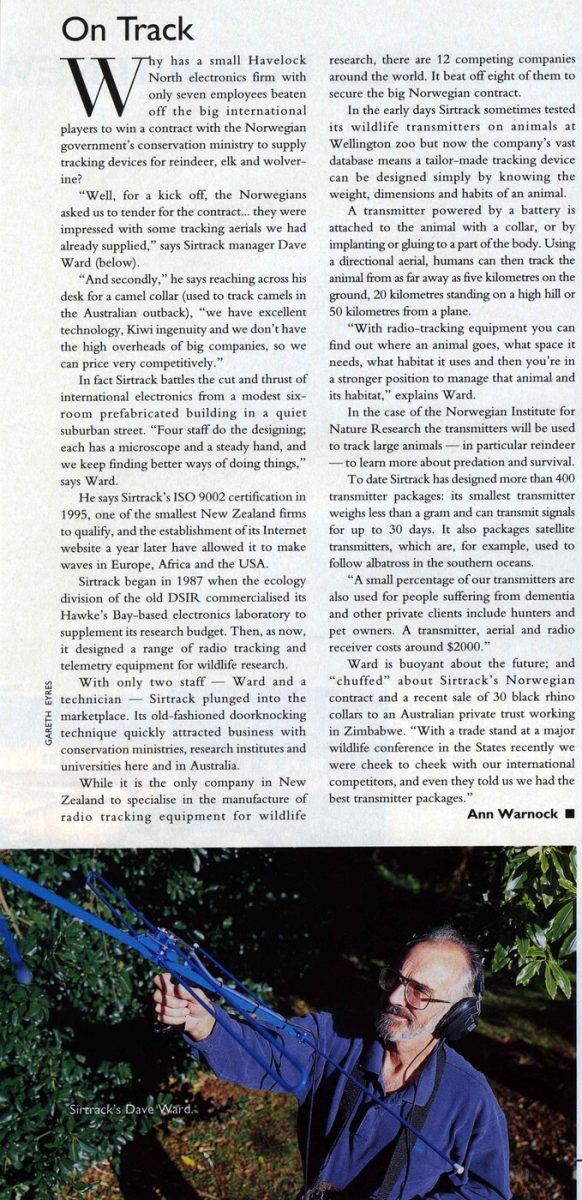On Track
Why has a small Havelock North electronics firm with only seven employees beaten off the big international players to win a contract with the Norwegian government’s conservation ministry to supply tracking devices for reindeer, elk and wolverine?
“Well, for a kick off, the Norwegians asked us to tender for the contract… they were impressed with some tracking aerials we had already supplied,” says Sirtrack manager Dave Ward (below).
“And secondly,” he says reaching across his desk for a camel collar (used to track camels in the Australian outback), “we have excellent technology, Kiwi ingenuity and we don’t have the high overheads of big companies, so we can price very competitively.”
In fact Sirtrack battles the cut and thrust of international electronics from a modest six-room prefabricated building in a quiet suburban street. “Four staff do the designing; each has a microscope and a steady hand, and we keep finding better ways of doing things,” says Ward.
He says Sirtrack’s ISO 9002 certification in 1995, one of the smallest New Zealand firms to qualify, and the establishment of its Internet website a year later have allowed it to make waves in Europe, Africa and the USA.
Sirtrack began in 1987 when the ecology division of the old DSIR commercialised its Hawke’s Bay-based electronics laboratory to supplement its research budget. Then, as now, it designed a range of radio tracking and telemetry equipment for wildlife research.
With only two staff – Ward and a technician – Sirtrack plunged into the marketplace. Its old-fashioned doorknocking technique quickly attracted business with conservation ministries, research institutes and universities here and in Australia.
While it is the only company in New Zealand to specialise in the manufacture of radio tracking equipment for wildlife research, there are 12 competing companies around the world. It beat off eight of them to secure the big Norwegian contract.
In the early days Sirtrack sometimes tested its wildlife transmitters on animals at Wellington zoo but now the company’s vast database means a tailor-made tracking device can be designed simply by knowing the weight, dimensions and habits of an animal.
A transmitter powered by a battery is attached to the animal with a collar, or by implanting or gluing to a part of the body. Using a directional aerial, humans can then track the animal from as far away as five kilometres on the ground, 20 kilometres standing on a high hill or 50 kilometres from a plane. “With radio-tracking equipment you can find out where an animal goes, what space it needs, what habitat it uses and then you’re in a stronger position to manage that animal and its habitat,” explains Ward.
In the case of the Norwegian Institute for Nature Research the transmitters will be used to track large animals – in particular reindeer to – learn more about predation and survival.
To date Sirtrack has designed more than 400 transmitter packages: its smallest transmitter weighs less than a gram and can transmit signals for up to 30 days. It also packages satellite transmitters, which are, for example, used to follow albatross in the southern oceans.
“A small percentage of our transmitters are also used for people suffering from dementia and other private clients include hunters and pet owners. A transmitter, aerial and radio receiver costs around $2000.”
Ward is buoyant about the future; and “chuffed” about Sirtrack’s Norwegian contract and a recent sale of 30 black rhino collars to an Australian private trust working in Zimbabwe. “With a trade stand at a major wildlife conference in the States recently we were cheek to cheek with our international competitors, and even they told us we had the best transmitter packages.”
Ann Warnock
Photo caption – Sirtrack’s Dave Ward












Do you know something about this record?
Please note we cannot verify the accuracy of any information posted by the community.